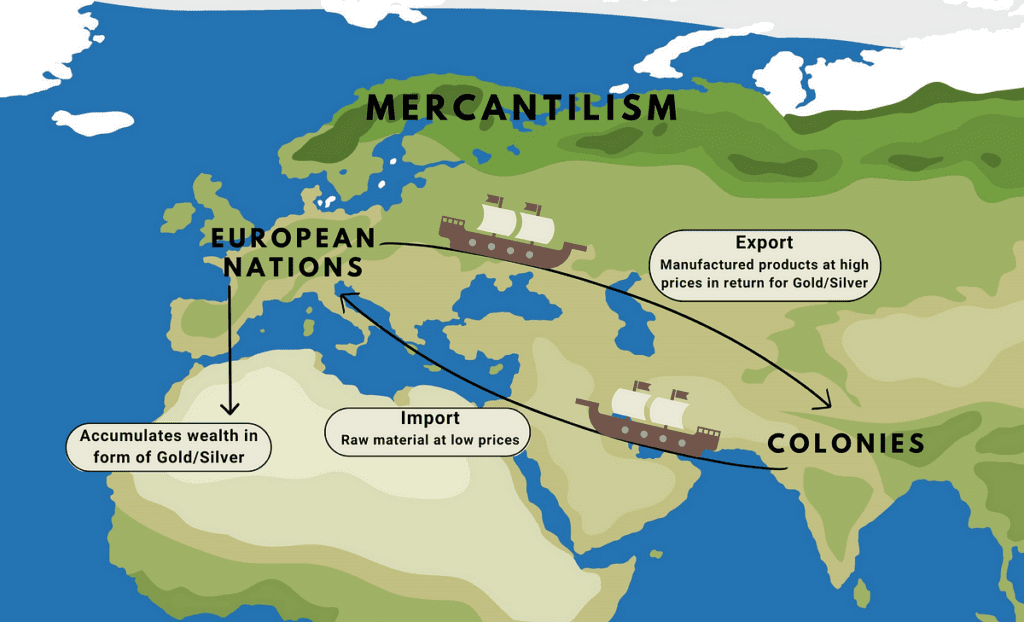Mercantilism: The Economic System That Shaped Modern Europe
Mercantilism is an economic theory that shaped the development of European nations from the 16th to the 18th centuries. It emphasized that a nation’s power was directly linked to its wealth, particularly in gold and silver. This blog post will explore mercantilism in detail, highlighting its key features, its impact on global trade, and why it eventually gave way to other economic ideologies. Let’s dive into the history and significance of mercantilism and its influence on world events.
What is Mercantilism?
Mercantilism is an economic theory and practice that emerged in Europe during the 16th century. The core belief of mercantilism is that a nation’s strength is determined by its wealth, especially in terms of gold and silver reserves. To achieve this, nations aimed to maintain a favorable balance of trade by exporting more goods than they imported. The government played a crucial role in regulating the economy, using tariffs and trade restrictions to protect domestic industries.
Key Features of Mercantilism
Government Regulation of Trade: Governments took an active role in controlling economic activities, including the regulation of imports and exports to ensure a surplus in trade.
Colonial Expansion: European nations established colonies to provide raw materials and serve as markets for their manufactured goods. Colonies were integral to mercantilism, as they enabled the mother country to acquire resources cheaply and sell finished products at a profit.
High Tariffs on Imports: To protect local industries and ensure a favorable balance of trade, mercantilist policies included high tariffs on imported goods. This discouraged the consumption of foreign products and promoted domestic manufacturing.
Accumulation of Wealth: Mercantilism emphasized the accumulation of wealth through the acquisition of gold and silver. The wealth of a nation was seen as the foundation of its political and military power.
Self-Sufficiency: Mercantilist countries aimed to be economically self-sufficient, reducing reliance on foreign imports and maximizing domestic production.
Impact of Mercantilism on European Powers and Colonies
Mercantilism significantly influenced the relationships between European powers and their colonies. European nations viewed their colonies primarily as sources of raw materials and captive markets for their manufactured goods. Colonies were expected to export resources back to the mother country, which would then produce finished goods for sale both domestically and in the colonies. This ensured that wealth flowed back to Europe, benefiting the colonial powers while limiting the economic independence of the colonies.
These mercantilist practices also led to increased competition among European nations for colonies and resources, fueling imperialism. Nations like England, France, and Spain competed fiercely to expand their colonial holdings, which often led to conflicts and wars.
The Decline of Mercantilism
By the late 18th century, mercantilism began to decline as new economic ideas emerged. Adam Smith, often called the father of modern economics, challenged mercantilist policies in his book The Wealth of Nations. Smith advocated for free-market capitalism, where economic activities are driven by individual entrepreneurship and market forces rather than government intervention.
The decline of mercantilism paved the way for capitalism and free trade, transforming economic interactions within Europe and around the world. This shift led to a more interconnected global economy, encouraging competition, innovation, and the rise of industrialization.
Mercantilism vs. Capitalism
While mercantilism focused on accumulating wealth through state control, capitalism emphasized individual freedom, private ownership, and free markets. Under capitalism, wealth is not just measured by gold and silver but by the productivity and value of goods and services generated within the economy. This shift laid the groundwork for the Industrial Revolution and the modern economic systems we know today.
5 Must-Know Facts About Mercantilism
Colonies as Economic Assets: Mercantilism encouraged the establishment of colonies to supply raw materials and serve as markets for the mother country’s goods.
Protectionist Policies: High tariffs and restrictions on imports were implemented to protect domestic industries.
Fueled Imperialism: Mercantilist policies led to increased competition for colonies, fueling European imperialism.
Self-Sufficiency Goal: Nations strove to minimize reliance on foreign goods, aiming for economic self-sufficiency.
Rise of Capitalism: The decline of mercantilism in the late 18th century made way for free-market theories like those of Adam Smith.
Frequently Asked Questions About Mercantilism
Q1: What was the main goal of mercantilism?
The main goal of mercantilism was to increase a nation’s wealth by maintaining a favorable balance of trade. This was achieved by maximizing exports and minimizing imports, thereby accumulating gold and silver.
Q2: How did mercantilist policies influence European colonial expansion?
Mercantilist policies drove European powers to establish colonies to provide raw materials and exclusive markets. Colonies were vital for ensuring that European nations could maximize exports and accumulate wealth.
Q3: Why did mercantilism decline?
Mercantilism declined due to the rise of new economic theories that advocated for free trade and less government intervention. Thinkers like Adam Smith argued that economies functioned more efficiently when individuals were free to pursue their own interests, leading to the development of capitalism.
Q4: What role did government play in a mercantilist economy?
In a mercantilist economy, the government played a significant role in regulating trade, setting tariffs, and controlling economic activities to ensure a favorable balance of trade. The state aimed to strengthen national wealth and power through these interventions.
Q5: How did mercantilism affect the colonies?
Colonies were heavily exploited under mercantilism. They were expected to supply raw materials to the mother country and serve as markets for finished goods. This ensured that wealth flowed back to Europe, limiting the economic development and independence of the colonies.
Conclusion
Mercantilism was a powerful economic theory that shaped the development of European nations and their colonial empires from the 16th to the 18th centuries. By emphasizing government control over trade and the accumulation of wealth, mercantilism laid the foundation for the modern nation-state and fueled imperial expansion. However, as economic thinking evolved, mercantilism gave way to the rise of capitalism and free trade, setting the stage for the industrial and economic revolutions that would transform the world.

